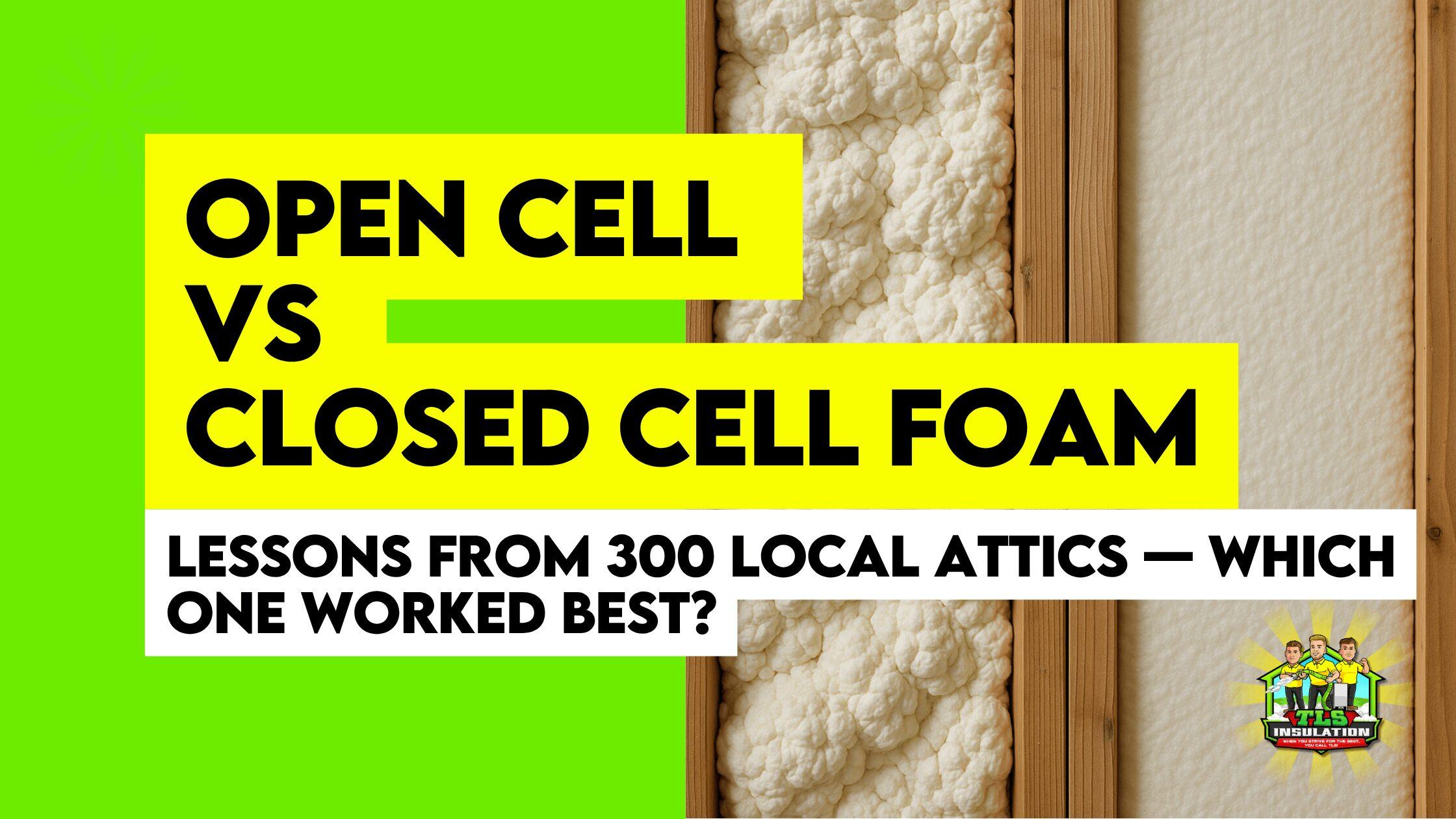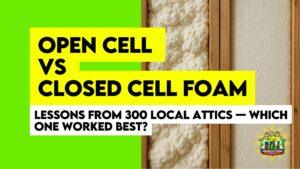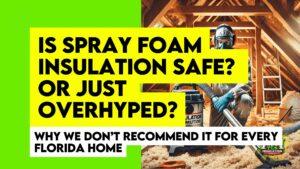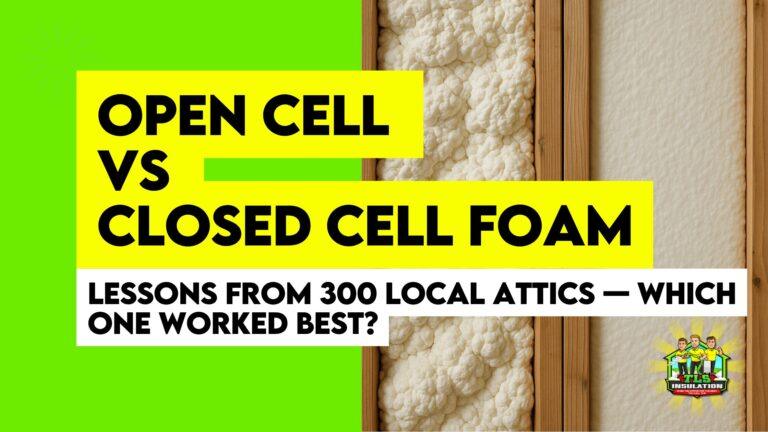Summary: Open cell foam is softer, less dense, and cheaper, while closed cell foam is denser, more rigid, moisture-resistant, and higher R-value insulation.
| Feature | Open Cell Foam | Closed Cell Foam |
| R-Value per Inch | ~3.5 (lower thermal resistance) | ~6–7 (higher thermal resistance) |
| Moisture Behavior | Vapor-permeable, can absorb humidity | Vapor retarder, resists condensation |
| Soundproofing | Excellent acoustic absorption | Moderate sound blocking |
| Structural Strength | Softer, not load-bearing | Rigid, adds wall/roof deck strength |
| Best For | Interior walls, sound control, lower cost | Roof decks, humid attics, hurricane zones |
For Florida homeowners weighing open cell vs closed cell spray foam insulation, the choice usually comes down to R-value, moisture control, and long-term durability.
From our work on more than 300 attics across Tampa, Sarasota, North Port and other South Florida’s cities, we’ve seen how Florida’s hot-humid Zone 2A climate and strict Building Code standards make the decision especially important.
Closed cell foam is denser, provides an R-value of ~6–7 per inch, and works as a vapor retarder, making it ideal for coastal and flood-prone areas where high humidity, storms, and hurricane resistance matter most.
By contrast, open cell foam is lighter, more affordable, and has an R-value of ~3.5 per inch. It excels in soundproofing and is a good fit for interior walls or attics with proper ventilation where moisture isn’t the top concern.
In places like Sarasota or Punta Gorda, many homeowners choose open cell to control noise and reduce upfront cost, while closed cell remains the go-to for roof decks, crawl spaces, and homes exposed to storm-driven rain.
In short: Choose open cell when you need cost savings and soundproofing, and closed cell when you need strength, moisture protection, and energy efficiency.
Stop Guessing the Cost — Let TLS Energy Savers Do the Math for You!
Don’t waste hours estimating insulation prices. Get a free, no-obligation consultation with our certified Florida insulation experts.
- Free, no-obligation insulation consultation.
- Get your real-time insulation cost — no math, no stress.
- Expert estimate based on your area, size, and material.

Difference Between Open Cell and Closed Cell Foam
| Factor | Open Cell Foam | Closed Cell Foam |
| Pros | Lower material cost per board foot, excellent soundproofing, lighter application, faster install. | Higher R-value per inch, moisture barrier, adds rigidity, hurricane resilience, longer lifespan. |
| Cons | Lower R-value per inch, not a vapor retarder, less durable in humid climates. | Higher upfront investment, limited soundproofing, denser (requires more skill to install). |
| Best When | Interior walls, ventilated attics, sound control, budget-conscious projects. | Roof decks, crawl spaces, flood-prone areas, Florida coastal homes, storm resilience. |
| Avoid If | You need high moisture resistance or hurricane-strength rigidity. | You want budget-friendly insulation or superior acoustic performance. |
| Cost (per sq ft installed) | $4–$5 (appears higher because applied thicker: 3.5–5.5 inches). | $3–$4 (less thickness needed: 2–3 inches). |
| ROI / Payback | Good for short-term savings; cost-effective for large coverage and soundproofing. | ROI in 3–5 years from lower cooling bills in Florida’s hot-humid climate. |
| Code & Standards | Meets ASTM E84 Class 1 fire rating; vapor-permeable. | Meets ASTM E84 Class 1 fire rating; vapor retarder; aligns with Florida Building Code Zone 2A. |
How Open Cell and Closed Cell Foam Perform in Florida Homes
Key Takeaways From This Article
- Open cell foam is cheaper per board foot and excels at soundproofing, but isn’t a moisture barrier.
- Closed cell foam provides higher R-value, hurricane resilience, and moisture protection, but costs more upfront.
- Florida homeowners often pick open-cell for attics and sound control, closed-cell for roof decks, crawl spaces, and flood-prone zones.
- ROI differs: open cell is budget-friendly coverage; closed cell pays back in 3–5 years via lower cooling bills in Florida’s Zone 2A climate.
So we build solutions based on real-world data. With choosing a superior form of spray foam insulation between open cell insulation and closed cell spray foam insulation, we take a data set from over 300 local homes in Tampa, Fort Lauderdale, and Sarasota; from attics to basements. By conducting blower-door tests and energy audits, we tracked actual cooling cost savings, air leakage reduction, and humidity control.
R-Value, Moisture, and Durability: What We Learned from 300 South Florida Projects
From our experience insulating over 300 attics and crawl spaces in South Florida including Tampa, Sarasota, and Fort Lauderdale, we’ve observed clear performance differences:
- Closed cell foam consistently reduced cooling loads in coastal and flood-prone homes, thanks to its higher R-value per inch (~6–7), strong vapor retarder properties, and compliance with the Florida Building Code (Energy Conservation, 8th Edition, Zone 2A), which requires attic insulation levels up to R-38 in many South Florida homes
- Open cell foam delivered excellent soundproofing and cost-effective coverage in ventilated attics and interior walls, especially where homeowners prioritized acoustic comfort.
- In high-humidity areas, closed cell foam prevented condensation and mold by forming a reliable moisture barrier, while open cell required proper ventilation to perform well.
- Both foams met ASTM E84 Class 1 fire rating, but their strengths diverged: open cell for cost and sound control, closed cell for durability, storm resilience, and long-term energy efficiency.
Our field data confirms that “best choice” depends on your priorities: soundproofing and affordability (open cell) vs. moisture protection and energy efficiency (closed cell).
Open Cell vs Closed Cell Foam: A Side-by-Side Comparison for Florida Homeowners
R-Value: Insulation Efficiency
When choosing between open cell vs closed cell foam, you should first consider the R-value, which indicates insulation efficiency. Closed cell spray foam R value averages 6.5 per inch, making it the top choice for energy savings in Tampa or Cape Coral, where heat and humidity put a strain on cooling systems.
If you want superior insulation to keep cooling costs low, closed cell foam is the way to go. We’ve seen closed cell foam reduce cooling costs by up to 30% in Sarasota homes with poor insulation.
On the other hand, open cell spray foam R value is 3.5 per inch, and works well in attics and interior walls in homes with good ventilation in areas like Fort Lauderdale.
Takeaway: If maximum energy efficiency with minimal thickness is the goal, closed cell wins. Open cell still performs well when the assembly allows more thickness
Moisture Resistance: Handling Florida’s Humidity
- Closed cell: Functions as a vapor retarder, resists condensation on roof decks and in crawl spaces, and helps keep relative humidity in check in coastal areas (e.g., Fort Lauderdale, Miami-Dade).
- Open cell: Vapor-permeable and not a moisture barrier—best in ventilated attics or interior partitions where moisture isn’t the primary concern and the assembly can dry.Takeaway: In flood-prone or high-humidity zones, closed cell is the safer bet for moisture management. Open cell is fine where the design supports drying and ventilation.
Cost & ROI (installed per square foot vs board foot)
- Installed (Florida typical):
Open cell: $4–$5/sq ft (applied thicker: ~3.5–5.5″)
Closed cell: $3–$4/sq ft (less thickness: ~2–3″) - Why open cell can still be “cost-effective”: material is cheaper per board foot, and it’s ideal for large coverage and sound control where a vapor retarder isn’t required.
- ROI lens: Closed cell’s higher R-value per inch and superior air-sealing can deliver faster cooling-bill savings in hot-humid Zone 2A; open cell is budget-friendly for big areas and interior walls.
Note: Most online guides quote per board foot (1 sq ft at 1″ thick). Contractors quote per sq ft installed at the actual thickness—hence the apparent price flip.
Stop Guessing the Cost — Let TLS Energy Savers Do the Math for You!
Don’t waste hours estimating insulation prices. Get a free, no-obligation consultation with our certified Florida insulation experts.
- Free, no-obligation insulation consultation.
- Get your real-time insulation cost — no math, no stress.
- Expert estimate based on your area, size, and material.

Strength, Expansion & Hurricane Resilience
- Closed cell (~2 lb/ft³): Dense and rigid, adds structural strength to roof decks and walls, improves wind uplift resistance—useful in Palm Beach County and other hurricane-exposed areas.
- Open cell (~0.5 lb/ft³): Expands aggressively to fill irregular cavities; softer feel, excellent sound absorption for bedrooms and living areas (e.g., Sarasota interiors).Takeaway: Choose closed cell when you want added rigidity and weather resilience; choose open cell when soundproofing and cavity fill are the priorities.
Expansion and Durability
One of the major differences between open cell and closed cell expansion is the foam’s density. Closed cell foam provides more rigidity, making it perfect for applications requiring added structural support in places like roof decks in Palm Beach County.
For homes in areas like Cape Coral, where strength against heavy winds is essential, closed cell foam is the most effective choice.
On the other hand, open cell foam expands greatly during installation, offering a softer insulation that is perfect for soundproofing and filling irregular spaces like walls in Sarasota homes.
Which One Florida Homeowners Should Pick
- Choose open cell if: interior walls or ventilated attics; soundproofing and budget matter more than vapor control.
- Choose closed cell if:roof decks, crawl spaces, coastal or flood-prone homes; you need a vapor retarder, higher R-value, and extra durability.
Health & Safety: VOCs, Isocyanates, and Air Quality in Open vs Closed Cell Foam
Choosing the right spray foam isn’t only about insulation performance — it’s also about indoor air quality, chemical exposure, and installation safety.
Both open and closed cell foams meet ASTM E84 Class 1 fire rating, but they behave differently in terms of VOC emissions, isocyanates, and moisture impact. Proper installation and ventilation are essential for compliance with the Florida Building Code (Energy Conservation, Zone 2A) and maintaining a safe living environment..
| Aspect | Open Cell Foam | Closed Cell Foam |
| Spray Foam Chemicals | Typically lower chemical density; fewer isocyanates when low-VOC formulas are used. | Higher concentration of isocyanates; requires strict handling and ventilation during install. |
| Moisture Resistance | Vapor-permeable; not a moisture barrier, so humidity can pass through in Florida’s hot-humid climate. | Water-resistant and functions as a vapor retarder; reduces condensation risks in attics and crawl spaces. |
| Off-Gassing Timeline | Off-gassing generally shorter (24–48 hours) with low-VOC formulas; ventilation clears fumes faster. | Longer off-gassing (48–72 hours) due to denser chemical structure; proper ventilation and curing are critical. |
| Indoor Air Quality | Safer option when low-VOC foams are used; good for interior partitions and living spaces. | Higher VOC potential, but safe when sealed in unvented attics and roof decks with correct ignition barriers. |
| Safety & Standards | Meets ASTM E84 Class 1; requires thermal barriers in living spaces. | Meets ASTM E84 Class 1; aligns with Florida Building Code Zone 2A for unvented roof assemblies and moisture control. |
Key Takeaways
- Isocyanates & VOCs: Both foam types release compounds during installation; closed cell carries more risk but is manageable with certified installers and ventilation.
- Moisture safety: Closed cell adds an extra layer of moisture defense critical for South Florida’s humidity and flood-prone areas, while open cell must be paired with proper ventilation.
- Occupancy timeline: Homeowners should plan to vacate during installation — typically 1–2 days for open cell, and 2–3 days for closed cell.
- Compliance matters: Correct installation with thermal barriers, air-sealing, and ventilation is essential to meet FBC requirements and protect indoor air quality long-term.
Cost & ROI in Real Numbers: What We’ve Seen in Tampa, Sarasota, and Cape Coral
From more than 300 local projects, we’ve tracked how open cell and closed cell spray foam perform in Zone 2A’s hot-humid climate. The results show clear tradeoffs between upfront cost, R-value efficiency, and long-term energy savings.
Installed Cost (per square foot, Florida average)
- Open Cell Foam: $4–$5 per sq ft (applied 3.5–5.5″ thick).
- Closed Cell Foam: $3–$4 per sq ft (applied 2–3″ thick).
Note: Online guides usually list costs per board foot (1 sq ft at 1″ thick). Contractors in Florida quote per square foot installed at the required thickness, which is why open cell may appear higher.
Five-Year Payback
- Open Cell Foam: Payback in 3–5 years, mainly from lower installation cost and coverage efficiency in attics and interior walls.
- Closed Cell Foam: Payback in 2–4 years, especially in coastal or moisture-prone homes where reduced HVAC runtime saves more.
- Florida Power & Light Rebates (FPL): Homeowners may qualify for up to $150 in rebates when insulation upgrades meet program standards.
Cooling Bill Reduction (Based on Florida Conditions)
- Open Cell Foam: Typically cuts cooling bills by ~15–20% in ventilated attics and interior wall applications.
- Closed Cell Foam: Cuts cooling bills by ~20–30% in roof decks, crawl spaces, and unvented attic assemblies, where moisture and air infiltration are critical
Stop Guessing the Cost — Let TLS Energy Savers Do the Math for You!
Don’t waste hours estimating insulation prices. Get a free, no-obligation consultation with our certified Florida insulation experts.
- Free, no-obligation insulation consultation.
- Get your real-time insulation cost — no math, no stress.
- Expert estimate based on your area, size, and material.

Open Cell or Closed Cell? How to Decide Based on Cost, Climate & Application
Which foam should you choose? The answer depends on budget, moisture conditions, and structural needs. Here’s a quick decision guide based on what we’ve seen in Florida homes.
| Best Choice If… | Open Cell Foam | Closed Cell Foam |
| Budget | More affordable upfront cost; cost-effective for large attics and interior walls. | Higher upfront investment but faster ROI in energy savings for moisture-prone homes. |
| Soundproofing | Excellent for busy neighborhoods like Fort Lauderdale or Riverview; ideal for interior partitions. | Minimal sound absorption. |
| Moisture Conditions | Works in ventilated attics or dry climates (e.g., Tampa, Sarasota). Requires airflow. | Superior moisture barrier; ideal for flood zones (Cape Coral, Miami-Dade). |
| Structural Strength | Flexible, softer foam; does not add rigidity. | Adds rigidity and hurricane uplift resistance; strengthens roof decks and exterior walls. |
| Best Applications | Interior walls, ventilated attics, sound control projects. | Crawl spaces, basements, unvented attics, coastal homes, flood-prone areas. |
Frequently Asked Questions (FAQs)
What is better, open cell or closed cell foam?
Closed cell foam offers higher R-value and better moisture resistance, making it ideal for humid Florida homes in areas like Tampa and Fort Lauderdale. Open cell foam, however, is more affordable and provides excellent soundproofing, making it a better fit for interior walls or well-ventilated attics.
Is open cell spray foam good for attics in Florida?
Yes, open cell foam works well in ventilated attics and interior spaces because it expands to fill cavities and provides soundproofing. However, in Florida’s hot-humid Zone 2A, it must be paired with proper ventilation to prevent moisture buildup.
Does closed cell foam meet Florida Building Code requirements?
Closed cell foam typically provides R-6–7 per inch and functions as a vapor retarder, helping homes meet or exceed Florida Building Code Energy Conservation requirements for R-30 attic insulation and tighter air-sealing.
Which foam is better for flood-prone or coastal homes?
Closed cell foam is better for flood zones and coastal areas like Miami-Dade or Cape Coral. Its moisture resistance and rigidity protect against condensation, mold, and hurricane uplift, making it the safer long-term investment.
Is spray foam insulation safe for indoor air quality?
Both foams contain chemicals, but low-VOC open cell foam generally has a shorter off-gassing period (24–48 hours). Closed cell foam may release VOCs for 48–72 hours but is safe once cured, especially when installed with proper ventilation and ignition barriers.
Which option has the best return on investment (ROI)?
- Closed cell foam: higher upfront cost, but typically pays back in 2–4 years in coastal Florida homes due to energy savings and moisture protection.
- Open cell foam: more affordable upfront, good ROI for large coverage areas like attics or interior walls.










